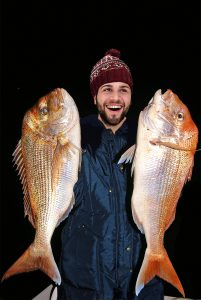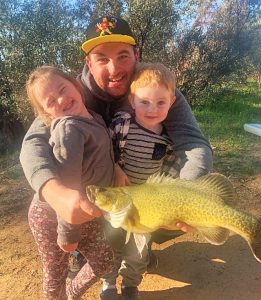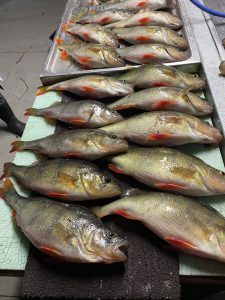
Ken Treloar with his winter snapper catch from Corio Bay (Picture: Jason Treloar).
Corio Bay/Bellarine Peninsula
Jason Treloar and Harley Griffiths have been picking up the occasional good size snapper near the Corio Channel, North Shore during winter, and Jason’s nephew Ken has been itching to have a go.
This was even after being told that it was usually in the cold, early hours of the morning before any snapper would likely appear.
Anyway, a late-night run with the sounder running, revealed a pod of fish near Corio Quay and over went the lines. And, it was Kenny in the hot seat, eventually catching two fish of around 6 and 7 kg, which certainly put a smile on his face.
Daylight fishing has also been good with garfish being taken from the various structures around Corio Bay’s inner harbour, St Helens promenade in particular, which – from my observation – has been rather crowded at times.
Rod Ludlow of Beachlea Boat Hire at Indented Head reports that on Saturday, flathead saved the day once more with squid and whiting being all but absent. Best results were had by anglers fishing on the drift out in 12-14 metres of water down toward St Leonards.

Stephen Eales with daughter Lily 6, and son Mason 3, and the 53 cm cod he caught from the Loddon River at Bridgewater.
Off the Beach
Arriving at the beach, just north east of the Torquay boat ramp at around midnight on Saturday, Ray Millman found the sea fairly calm, and at first the fishing was slow. However, with the tide rising, he was hopeful of catching something decent.
Eventually, the usual unwanted species like draughtboard sharks and Whitley skates moved in on his baits, but at around 3.00 am he hooked a good size fish on a squid head that took quite a bit of line before the hook pulled free.
His eventual reward came on the high tide at around 4.20 am when he hooked what turned out to be a 10 kg gummy shark that also took a squid head.

John Hewett-Longtack’s catch of redfin from Lake Purrumbete (Picture: John Clements).
Freshwater
Simon Werner had nothing to report himself, but his friend Michael Dean dropped in on the way back from Wurdiboluc Reservoir with two brown trout weighing 1.5 kg apiece. These were both taken on mudeyes fished beneath a float.
John Clements of Lake Purrumbete Holiday Park reports that redfin are still on offer, and among those to catch them was John Hewett-Longtack of Port Fairy who caught 50 odd on soft plastics, worms and live minnow.
John also reports the capture of a brown trout of 3 kg that was taken by an angler trolling a Tassie Devil lure.
Michael Evans of Victorian Inland Charters reports that he’s been catching chinook to 1.5 kg from Purrumbete on pilchard fillets suspended just above the bottom. He also reports finding redfin for his clients who’ve been catching them on various baits and lures.
Kevin Wild of the Maryborough Angling Club reports that both Cairn Curran and Tullaroop Reservoirs have become less than productive with the influx of fresh water, which has dropped the temperature in both waters to around 10 degrees Celsius.
Club member Stephen Eales had better luck after taking his family on a picnic/fishing trip to Bridgewater on the Loddon River, off the Calder Highway where he caught a 53 cm Murray cod that took a bait of cheese.
Colin asks:
Geoff, I’ve heard the term “salt-wedge” applied to some estuaries; what does it mean?
Colin, my understanding of a salt-wedge estuary is that when the tidal interaction with the sea is either very weak or absent, the salt water within the estuary, being denser than the fresh water coming down the river, has the potential to form a layer beneath the fresh.
This layer tends to eventually become roughly wedge-shaped with the thinnest edge beginning at the bottom furthest upstream from the mouth, its comparative depth becoming greater the further one travels downstream.
Should an estuary become completely closed to the sea, and the delineation between salt and fresh becoming more distinct over time, the deepest levels of the estuary become stagnant, anaerobic and toxic.
With no action being taken to open such an estuary to the sea, the greater the potential is for catastrophic kills to occur. This is because when opening eventually does occur, the mixture this toxicity with the formerly benign layers kills fish and other aquatic species.
